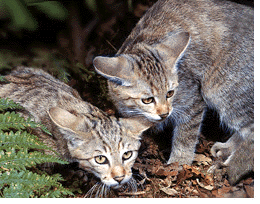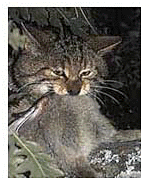...Best of Sicily
presents... Best of Sicily Magazine. ... Dedicated to Sicilian art, culture, history, people, places and all things Sicilian. |
by Vincenzo Mormino | ||
Magazine Best of Sicily Arts & Culture Fashion Food & Wine History & Culture About Us Travel Faqs Contact Map of Sicily |
The Sicilian cat's survival has been threatened by three forces --hunting, hybridization and the loss of its habitat. In theory at least, the hunting of these rare cats is a thing of the past; it is now illegal. Breeding with Sicily's ubiquitous stray cats could endanger the purity of this unique species. Deforestation, coupled with disappearance of lakes and streams, is another challenge. The gradual loss of woodlands has meant the loss of the cat's natural prey. The coat of the wild cat of Sicily and Sardinia is heathery grey with faint black stripes and occasional spots. It stalks hare, rabbit, mice and other small The wild cat of Sicily seems to have escaped extinction, but there is no escaping the fact that this creature, so numerous in the nineteenth century, is a victim of the lax (if not downright ignorant) attitude of most Sicilians toward preservation of our island's flora and fauna, and serious conservation efforts are just beginning. Italian law makes Felis Lybica Sarda a protected species, meaning it is illegal to harm or kill these cats. Hunted and starved almost to extinction, the wild cat owes it miraculous survival here to its anonymity rather than to any law. The defiant carnivore remains a small but important link in the chain of Sicily's precious natural heritage. About the Author: Vincenzo Mormino is active in wildlife preservation throughout Sicily. He previously wrote about the purple swamp hen for our July 2001 issue. | |
Top of Page |
 Felis Lybica Sarda. That scientific name describes the grey wild cat that inhabits the few forests of the Sicilian mountains. Estimates of the endangered feline's population in the Madonie and Nebrodi mountains, on the Ficuzza nature reserve, and particularly in the forests around Mount Etna, place the population at a few dozen or perhaps a hundred. These wild cats are similar to their Sardinian cousins, subspecies of a race (felis lybica) that lives in some parts of Africa, preferring woods to fields, deserts and jungles. Felis Lybica is believed to be the ancestor of the slightly heavier European species Felis Silvestris which inhabits mountainous Continental regions and Scotland. Indeed, the African species is considered the ancestor of the domestic cats present in Europe, though Sicily and Sardinia appear to be the only European regions where it is present today. The cats are born in litters of two to four, maturing quickly. By the age of twelve months they leave the mother and hunt on their own, their eyes having turned from blue to amber.
Felis Lybica Sarda. That scientific name describes the grey wild cat that inhabits the few forests of the Sicilian mountains. Estimates of the endangered feline's population in the Madonie and Nebrodi mountains, on the Ficuzza nature reserve, and particularly in the forests around Mount Etna, place the population at a few dozen or perhaps a hundred. These wild cats are similar to their Sardinian cousins, subspecies of a race (felis lybica) that lives in some parts of Africa, preferring woods to fields, deserts and jungles. Felis Lybica is believed to be the ancestor of the slightly heavier European species Felis Silvestris which inhabits mountainous Continental regions and Scotland. Indeed, the African species is considered the ancestor of the domestic cats present in Europe, though Sicily and Sardinia appear to be the only European regions where it is present today. The cats are born in litters of two to four, maturing quickly. By the age of twelve months they leave the mother and hunt on their own, their eyes having turned from blue to amber. animals --sometimes lizards and birds. Just slightly larger than a domestic cat, it is, from a distance, sometimes indistinguishable from a large grey tabby. Some experts believe the grey tabby pattern was introduced in Europe with Felis Lybica. The wild cat stays hidden during most of the day, hunting at night. Sightings are rare. Except for dedicated nature-lovers, few Sicilians even know of the existence of the wild cat.
animals --sometimes lizards and birds. Just slightly larger than a domestic cat, it is, from a distance, sometimes indistinguishable from a large grey tabby. Some experts believe the grey tabby pattern was introduced in Europe with Felis Lybica. The wild cat stays hidden during most of the day, hunting at night. Sightings are rare. Except for dedicated nature-lovers, few Sicilians even know of the existence of the wild cat.